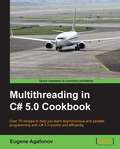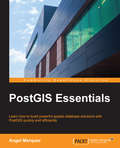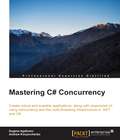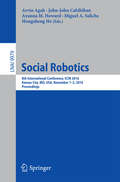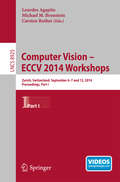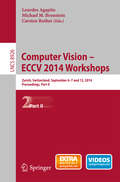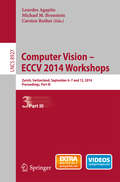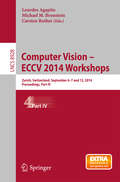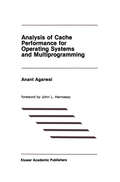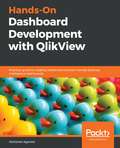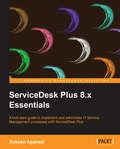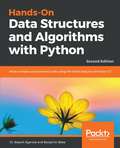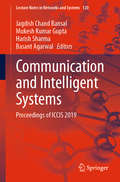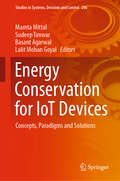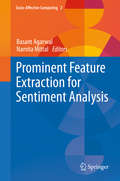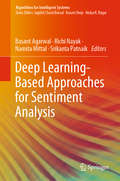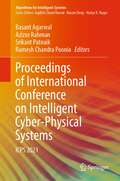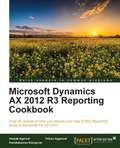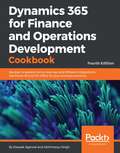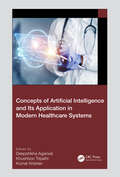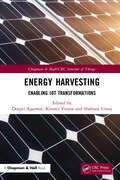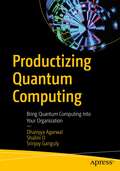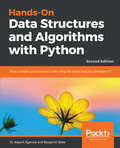- Table View
- List View
Multithreading in C# 5.0 Cookbook
by Eugene AgafonovCookbook.Multithreading in C# 5.0 Cookbook is written for existing C# developers who want a complete, professional, and authoritative guide to multithreading. You don't need any experience with multithreaded programming to use this book.
Multithreading with C# Cookbook - Second Edition
by Eugene AgafonovOver 70 recipes to get you writing powerful and efficient multithreaded, asynchronous, and parallel programs in C# 6.0 About This Book Rewritten and updated to take advantage of the latest C# 6 features Learn about multithreaded, asynchronous, and parallel programming through hands-on, code-first examples Use these recipes to build fast, scalable, and reliable applications in C# Who This Book Is For This book is aimed at those who are new to multithreaded programming, and who are looking for a quick and easy way to get started. It is assumed that you have some experience in C# and .NET already, and you should also be familiar with basic computer science terminology and basic algorithms and data structures. What You Will Learn Use C# 6.0 asynchronous language features Work with raw threads, synchronize threads, and coordinate their work Develop your own asynchronous API with Task Parallel Library Work effectively with a thread pool Scale up your server application with I/O threads Parallelize your LINQ queries with PLINQ Use common concurrent collections Apply different parallel programming patterns Use Reactive Extensions to run asynchronous operations and manage their options In Detail Multi-core processors are synonymous with computing speed and power in today's world, which is why multithreading has become a key concern for C# developers. Multithreaded code helps you create effective, scalable, and responsive applications. This is an easy-to-follow guide that will show you difficult programming problems in context. You will learn how to solve them with practical, hands-on, recipes. With these recipes, you'll be able to start creating your own scalable and reliable multithreaded applications. Starting from learning what a thread is, we guide you through the basics and then move on to more advanced concepts such as task parallel libraries, C# asynchronous functions, and much more. Rewritten to the latest C# specification, C# 6, and updated with new and modern recipes to help you make the most of the hardware you have available, this book will help you push the boundaries of what you thought possible in C#. Style and approach This is an easy-to-follow guide full of hands-on examples of real-world multithreading tasks. Each topic is explained and placed in context, and for the more inquisitive, there are also more in-depth details of the concepts used.
Mastering C# Concurrency
by Eugene Agafonov Andrew KoryavchenkoCreate robust and scalable applications along with responsive UI using concurrency and the multi-threading infrastructure in .NET and C# About This Book • Learn to combine your asynchronous operations with Task Parallel Library • Master C#'s asynchronous infrastructure and use asynchronous APIs effectively to achieve optimal responsiveness of the application • An easy-to-follow, example-based guide that helps you to build scalable applications using concurrency in C# Who This Book Is For If you are a C# developer who wants to develop modern applications in C# and wants to overcome problems by using asynchronous APIs and standard patterns, then this book is ideal for you. Reasonable development knowledge, an understanding of core elements and applications related to the .Net platform, and also the fundamentals of concurrency is assumed. What You Will Learn • Apply general multithreading concepts to your application's design • Leverage lock-free concurrency and learn about its pros and cons to achieve efficient synchronization between user threads • Combine your asynchronous operations with Task Parallel Library • Make your code easier with C#'s asynchrony support • Use common concurrent collections and programming patterns • Write scalable and robust server-side asynchronous code • Create fast and responsible client applications • Avoid common problems and troubleshoot your multi-threaded and asynchronous applications In Detail Starting with the traditional approach to concurrency, you will learn how to write multithreaded concurrent programs and compose ways that won't require locking. You will explore the concepts of parallelism granularity, and fine-grained and coarse-grained parallel tasks by choosing a concurrent program structure and parallelizing the workload optimally. You will also learn how to use task parallel library, cancellations, timeouts, and how to handle errors. You will know how to choose the appropriate data structure for a specific parallel algorithm to achieve scalability and performance. Further, you'll learn about server scalability, asynchronous I/O, and thread pools, and write responsive traditional Windows and Windows Store applications. By the end of the book, you will be able to diagnose and resolve typical problems that could happen in multithreaded applications. Style and approach An easy-to-follow, example-based guide that will walk you through the core principles of concurrency and multithreading using C#.
Social Robotics: 8th International Conference, ICSR 2016, Kansas City, MO, USA, November 1-3, 2016 Proceedings (Lecture Notes in Computer Science #9979)
by Arvin Agah John-John Cabibihan Ayanna M. Howard Miguel A. Salichs Hongsheng HeThis book constitutes the refereed proceedings of the 8th International Conference on Social Robotics, ICSR 2016, held in Kansas City, MO, USA, in November 2016. The 98 revised full papers presented were carefully reviewed and selected from 107 submissions.The theme of the 2016 conference is Sociorobotics: Design and implementation of social behaviors of robots interacting with each other and humans. In addition to technical sessions, ICSR 2016 included three workshops: The Synthetic Method in Social Robotics (SMSR 2016), Social Robots: A Tool to Advance Interventions for Autism, and Using Social Robots to Improve the Quality of Life in the Elderly.
Computer Vision - ECCV 2014 Workshops: Zurich, Switzerland, September 6-7 and 12, 2014, Proceedings, Part I (Lecture Notes in Computer Science #8925)
by Lourdes Agapito Michael M. Bronstein Carsten RotherThe four-volume set LNCS 8925, 8926, 8927, and 8928 comprises the refereed post-proceedings of the Workshops that took place in conjunction with the 13th European Conference on Computer Vision, ECCV 2014, held in Zurich, Switzerland, in September 2014. The 203 workshop papers were carefully reviewed and selected for inclusion in the proceedings. They were presented at workshops with the following themes: where computer vision meets art; computer vision in vehicle technology; spontaneous facial behavior analysis; consumer depth cameras for computer vision; "chalearn" looking at people: pose, recovery, action/interaction, gesture recognition; video event categorization, tagging and retrieval towards big data; computer vision with local binary pattern variants; visual object tracking challenge; computer vision + ontology applies cross-disciplinary technologies; visual perception of affordance and functional visual primitives for scene analysis; graphical models in computer vision; light fields for computer vision; computer vision for road scene understanding and autonomous driving; soft biometrics; transferring and adapting source knowledge in computer vision; surveillance and re-identification; color and photometry in computer vision; assistive computer vision and robotics; computer vision problems in plant phenotyping; and non-rigid shape analysis and deformable image alignment. Additionally, a panel discussion on video segmentation is included. .
Computer Vision - ECCV 2014 Workshops: Zurich, Switzerland, September 6-7 and 12, 2014, Proceedings, Part II (Lecture Notes in Computer Science #8926)
by Lourdes Agapito Michael M. Bronstein Carsten RotherThe four-volume set LNCS 8925, 8926, 8927, and 8928 comprises the thoroughly refereed post-workshop proceedings of the Workshops that took place in conjunction with the 13th European Conference on Computer Vision, ECCV 2014, held in Zurich, Switzerland, in September 2014.The 203 workshop papers were carefully reviewed and selected for inclusion in the proceedings. They where presented at workshops with the following themes: where computer vision meets art; computer vision in vehicle technology; spontaneous facial behavior analysis; consumer depth cameras for computer vision; "chalearn" looking at people: pose, recovery, action/interaction, gesture recognition; video event categorization, tagging and retrieval towards big data; computer vision with local binary pattern variants; visual object tracking challenge; computer vision + ontology applies cross-disciplinary technologies; visual perception of affordance and functional visual primitives for scene analysis; graphical models in computer vision; light fields for computer vision; computer vision for road scene understanding and autonomous driving; soft biometrics; transferring and adapting source knowledge in computer vision; surveillance and re-identification; color and photometry in computer vision; assistive computer vision and robotics; computer vision problems in plant phenotyping; and non-rigid shape analysis and deformable image alignment. Additionally, a panel discussion on video segmentation is included.
Computer Vision - ECCV 2014 Workshops: Zurich, Switzerland, September 6-7 and 12, 2014, Proceedings, Part III (Lecture Notes in Computer Science #8927)
by Lourdes Agapito Michael M. Bronstein Carsten RotherThe four-volume set LNCS 8925, 8926, 8927 and 8928 comprises the thoroughly refereed post-workshop proceedings of the Workshops that took place in conjunction with the 13th European Conference on Computer Vision, ECCV 2014, held in Zurich, Switzerland, in September 2014.The 203 workshop papers were carefully reviewed and selected for inclusion in the proceedings. They where presented at workshops with the following themes: where computer vision meets art; computer vision in vehicle technology; spontaneous facial behavior analysis; consumer depth cameras for computer vision; "chalearn" looking at people: pose, recovery, action/interaction, gesture recognition; video event categorization, tagging and retrieval towards big data; computer vision with local binary pattern variants; visual object tracking challenge; computer vision + ontology applies cross-disciplinary technologies; visual perception of affordance and functional visual primitives for scene analysis; graphical models in computer vision; light fields for computer vision; computer vision for road scene understanding and autonomous driving; soft biometrics; transferring and adapting source knowledge in computer vision; surveillance and re-identification; color and photometry in computer vision; assistive computer vision and robotics; computer vision problems in plant phenotyping; and non-rigid shape analysis and deformable image alignment. Additionally, a panel discussion on video segmentation is included.
Computer Vision - ECCV 2014 Workshops: Zurich, Switzerland, September 6-7 and 12, 2014, Proceedings, Part IV (Lecture Notes in Computer Science #8928)
by Lourdes Agapito Michael M. Bronstein Carsten RotherThe four-volume set LNCS 8925, 8926, 8927, and 8928 comprises the thoroughly refereed post-workshop proceedings of the Workshops that took place in conjunction with the 13th European Conference on Computer Vision, ECCV 2014, held in Zurich, Switzerland, in September 2014.The 203 workshop papers were carefully reviewed and selected for inclusion in the proceedings. They where presented at workshops with the following themes: where computer vision meets art; computer vision in vehicle technology; spontaneous facial behavior analysis; consumer depth cameras for computer vision; "chalearn" looking at people: pose, recovery, action/interaction, gesture recognition; video event categorization, tagging and retrieval towards big data; computer vision with local binary pattern variants; visual object tracking challenge; computer vision + ontology applies cross-disciplinary technologies; visual perception of affordance and functional visual primitives for scene analysis; graphical models in computer vision; light fields for computer vision; computer vision for road scene understanding and autonomous driving; soft biometrics; transferring and adapting source knowledge in computer vision; surveillance and re-identification; color and photometry in computer vision; assistive computer vision and robotics; computer vision problems in plant phenotyping; and non-rigid shape analysis and deformable image alignment. Additionally, a panel discussion on video segmentation is included.
Analysis of Cache Performance for Operating Systems and Multiprogramming (The Springer International Series in Engineering and Computer Science #69)
by AgarwalAs we continue to build faster and fast. er computers, their performance is be coming increasingly dependent on the memory hierarchy. Both the clock speed of the machine and its throughput per clock depend heavily on the memory hierarchy. The time to complet. e a cache acce88 is oft. en the factor that det. er mines the cycle time. The effectiveness of the hierarchy in keeping the average cost of a reference down has a major impact on how close the sustained per formance is to the peak performance. Small changes in the performance of the memory hierarchy cause large changes in overall system performance. The strong growth of ruse machines, whose performance is more tightly coupled to the memory hierarchy, has created increasing demand for high performance memory systems. This trend is likely to accelerate: the improvements in main memory performance will be small compared to the improvements in processor performance. This difference will lead to an increasing gap between prOCe880r cycle time and main memory acce. time. This gap must be closed by improving the memory hierarchy. Computer architects have attacked this gap by designing machines with cache sizes an order of magnitude larger than those appearing five years ago. Microproce880r-based RISe systems now have caches that rival the size of those in mainframes and supercomputers.
Hands-On Dashboard Development with QlikView: Practical Guide To Creating Interactive And User-friendly Business Intelligence Dashboards
by Abhishek AgarwalThe book will help you build effective business intelligence dashboards using the latest features of QlikView. You will create different types of visualizations such as bar charts, interactive plots, and more. With this book, you will learn how to gain actionable insights from your data and communicate them across to relevant stakeholders in the best possible manner.
ServiceDesk Plus 8.x Essentials
by Ankush AgarwalThis is a practical, hands-on guide that assists you in setting up and efficiently managing ITSM.ServiceDesk Plus 8.x Essentials is for IT helpdesk managers, administrators, and staff, serving as a compendium for service management concepts useful for them.
Hands-On Data Structures and Algorithms with Python: Write Complex And Powerful Code Using The Latest Features Of Python 3. 7, 2nd Edition
by Basant AgarwalData structures help us to organize and align the data in a very efficient way. This book will surely help you to learn important and essential data structures through Python implementation for better understanding of the concepts.
Communication and Intelligent Systems: Proceedings of ICCIS 2019 (Lecture Notes in Networks and Systems #120)
by Basant Agarwal Jagdish Chand Bansal Harish Sharma Mukesh Kumar GuptaThis book gathers selected research papers presented at the International Conference on Communication and Intelligent Systems (ICCIS 2019), organised by Swami Keshvanand Institute of Technology, Management & Gramothan (SKIT), Jaipur, India and Rajasthan Technical University, Kota, India on 9–10 November 2019.This book presents a collection of state-of-the-art research work involving cutting-edge technologies for communication and intelligent systems. Over the past few years, advances in artificial intelligence and machine learning have sparked new research efforts around the globe, which explore novel ways of developing intelligent systems and smart communication technologies. The book presents single- and multi-disciplinary research on these themes in order to make the latest results available in a single, readily accessible source.
Energy Conservation for IoT Devices: Concepts, Paradigms and Solutions (Studies in Systems, Decision and Control #206)
by Basant Agarwal Mamta Mittal Lalit Mohan Goyal Sudeep TanwarThis book addresses the Internet of Things (IoT), an essential topic in the technology industry, policy, and engineering circles, and one that has become headline news in both the specialty press and the popular media. The book focuses on energy efficiency concerns in IoT and the requirements related to Industry 4.0. It is the first-ever “how-to” guide on frequently overlooked practical, methodological, and moral questions in any nations’ journey to reducing energy consumption in IoT devices. The book discusses several examples of energy-efficient IoT, ranging from simple devices like indoor temperature sensors, to more complex sensors (e.g. electrical power measuring devices), actuators (e.g. HVAC room controllers, motors) and devices (e.g. industrial circuit-breakers, PLC for home, building or industrial automation). It provides a detailed approach to conserving energy in IoT devices, and comparative case studies on performance evaluation metrics, state-of-the-art approaches, and IoT legislation.
Prominent Feature Extraction for Sentiment Analysis (Socio-Affective Computing #2)
by Basant Agarwal Namita MittalThe objective of this monograph is to improve the performance of the sentiment analysis model by incorporating the semantic, syntactic and common-sense knowledge. This book proposes a novel semantic concept extraction approach that uses dependency relations between words to extract the features from the text. Proposed approach combines the semantic and common-sense knowledge for the better understanding of the text. In addition, the book aims to extract prominent features from the unstructured text by eliminating the noisy, irrelevant and redundant features. Readers will also discover a proposed method for efficient dimensionality reduction to alleviate the data sparseness problem being faced by machine learning model. Authors pay attention to the four main findings of the book : -Performance of the sentiment analysis can be improved by reducing the redundancy among the features. Experimental results show that minimum Redundancy Maximum Relevance (mRMR) feature selection technique improves the performance of the sentiment analysis by eliminating the redundant features. - Boolean Multinomial Naive Bayes (BMNB) machine learning algorithm with mRMR feature selection technique performs better than Support Vector Machine (SVM) classifier for sentiment analysis. - The problem of data sparseness is alleviated by semantic clustering of features, which in turn improves the performance of the sentiment analysis.- Semantic relations among the words in the text have useful cues for sentiment analysis. Common-sense knowledge in form of ConceptNet ontology acquires knowledge, which provides a better understanding of the text that improves the performance of the sentiment analysis.
Deep Learning-Based Approaches for Sentiment Analysis (Algorithms for Intelligent Systems)
by Basant Agarwal Richi Nayak Namita Mittal Srikanta PatnaikThis book covers deep-learning-based approaches for sentiment analysis, a relatively new, but fast-growing research area, which has significantly changed in the past few years. The book presents a collection of state-of-the-art approaches, focusing on the best-performing, cutting-edge solutions for the most common and difficult challenges faced in sentiment analysis research. Providing detailed explanations of the methodologies, the book is a valuable resource for researchers as well as newcomers to the field.
Proceedings of International Conference on Intelligent Cyber-Physical Systems: ICPS 2021 (Algorithms for Intelligent Systems)
by Basant Agarwal Azizur Rahman Ramesh Chandra Poonia Srikant PatnaikThis book presents innovative work by leading academics, researchers, and experts from industry which is useful for young researchers and students. This book includes selected papers from International Conference on Intelligent Cyber-Physical Systems (ICPS 2021), held at Indian Institute of Information Technology Kota (IIIT Kota), MNIT Jaipur Campus, Jaipur, India, during 16-18 April 2021. The book is a collection of the state-of-the art research work in the cutting-edge technologies related to the artificial intelligence and cyber physical systems.
Microsoft Dynamics AX 2012 R3 Reporting Cookbook
by Deepak Agarwal Chhavi Aggarwal Kamalakannan ElangovanMicrosoft Dynamics AX 2012 R3 Reporting Cookbook is recommended for Dynamics AX developers and .NET-based SSRS developers looking to familiarize themselves with the new AX reporting framework.
Dynamics 365 for Finance and Operations Development Cookbook - Fourth Edition
by Deepak Agarwal Abhimanyu SinghOver 80 effective recipes to help you solve real-world Microsoft Dynamics 365 for Finance and Operations development problems About This Book • Learn all about the enhanced functionalities of Dynamics 365 for Finance and Operations and master development best practices • Develop powerful projects using new tools and features • Work through easy-to-understand recipes with step-by-step instructions and useful screenshots Who This Book Is For If you are a Dynamics AX developer primarily focused on delivering time-proven applications, then this book is for you. This book is also ideal for people who want to raise their programming skills above the beginner level, and at the same time learn the functional aspects of Dynamics 365 for Finance and Operations. Some X++ coding experience is expected. What You Will Learn • Explore data manipulation concepts in Dynamics 365 for Operations • Build scripts to assist data migration processes • Organize data in Dynamics 365 for Operations forms • Make custom lookups using AOT forms and dynamically generate them from X++ code • Create a custom electronic payment format and process a vendor payment using it • Integrate your application with Microsoft Office Suite and other external systems using various approaches • Export and import business data for further distribution or analysis • Improve your development efficiency and performance In Detail Microsoft Dynamics 365 for Finance and Operations has a lot to offer developers. It allows them to customize and tailor their implementations to meet their organization's needs. This Development Cookbook will help you manage your company or customer ERP information and operations efficiently. We start off by exploring the concept of data manipulation in Dynamics 365 for Operations. This will also help you build scripts to assist data migration, and show you how to organize data in forms. You will learn how to create custom lookups using Application Object Tree forms and generate them dynamically. We will also show you how you can enhance your application by using advanced form controls, and integrate your system with other external systems. We will help you script and enhance your user interface using UI elements. This book will help you look at application development from a business process perspective, and develop enhanced ERP solutions by learning and implementing the best practices and techniques. Style and approach The book follows a practical recipe-based approach, focusing on real-world scenarios and giving you all the information you need to build a strong Dynamics 365 for Finance and Operations implementation.
Concepts of Artificial Intelligence and its Application in Modern Healthcare Systems
by Deepshikha Agarwal Khushboo Tripathi Kumar KrishenThis reference text presents the usage of artificial intelligence in healthcare and discusses the challenges and solutions of using advanced techniques like wearable technologies and image processing in the sector. Features: Focuses on the use of artificial intelligence (AI) in healthcare with issues, applications, and prospects Presents the application of artificial intelligence in medical imaging, fractionalization of early lung tumour detection using a low intricacy approach, etc. Discusses an artificial intelligence perspective on wearable technology Analyses cardiac dynamics and assessment of arrhythmia by classifying heartbeat using electrocardiogram (ECG) Elaborates machine learning models for early diagnosis of depressive mental affliction This book serves as a reference for students and researchers analyzing healthcare data. It can also be used by graduate and post graduate students as an elective course.
Energy Harvesting: Enabling IoT Transformations (Chapman & Hall/CRC Internet of Things)
by Deepti Agarwal Kimmi Verma Shabana UroojEnergy Harvesting: Enabling IoT Transformations gives insight into the emergence of energy harvesting technology and its integration with IoT-based applications. The book educates the reader on how energy is harvested from different sources, increasing the effectiveness, efficiency and lifetime of IoT devices. • Discusses the technology and practices involved in energy harvesting for biomedical, agriculture and automobile industries • Compares the performance of IoT-based devices with and without energy harvesting for different applications • Studies the challenges and issues in the implementation of EH-IoT • Includes case studies on energy-harvesting approach for solar, thermal and RF sources • Analyzes the market and business opportunities for entrepreneurs in the field of EH-IoT. This book is primarily aimed at graduates and research scholars in wireless sensor networks. Scientists and R&D workers in industry will also find this book useful.
Energy Harvesting: Enabling IoT Transformations (Chapman & Hall/CRC Internet of Things)
by Deepti Agarwal Kimmi Verma Shabana UroojEnergy Harvesting: Enabling IoT Transformations gives insight into the emergence of energy harvesting technology and its integration with IoT-based applications. The book educates the reader on how energy is harvested from different sources, increasing the effectiveness, efficiency and lifetime of IoT devices. • Discusses the technology and practices involved in energy harvesting for biomedical, agriculture and automobile industries • Compares the performance of IoT-based devices with and without energy harvesting for different applications • Studies the challenges and issues in the implementation of EH-IoT • Includes case studies on energy-harvesting approach for solar, thermal and RF sources • Analyzes the market and business opportunities for entrepreneurs in the field of EH-IoT. This book is primarily aimed at graduates and research scholars in wireless sensor networks. Scientists and R&D workers in industry will also find this book useful.
Productizing Quantum Computing: Bring Quantum Computing Into Your Organization
by Dhairyya Agarwal Shalini D Srinjoy GangulyLeverage the benefits of quantum computing by identifying business use cases and understanding how to design and develop quantum products and services. This book will guide you to effectively productize quantum computing, including best practices, recommendations, and proven methods to help you navigate the challenges and risks of this emerging technology. The book starts with a thorough introduction to quantum computing, followed by its various algorithms and applications. You will then learn how to build a strong foundation in classical computing, seek practical experience, and stay up-to-date with the latest developments in the field. Moving forward, you will gain an understanding of how to conduct market research to identify business opportunities for quantum computing products and services. The authors then guide you through the process of developing a quantum roadmap and integrating quantum computing into an existing system. This is concluded by a demonstration of how to manage quantum computing projects and how to address their risks and challenges. After reading this book, you will understand quantum computing and how it can be applied to real-world business problems. What You Will Learn Identify business use cases for quantum computing and understand the potential benefits and risks of quantum applicationsDesign and develop quantum products and services by identifying quantum algorithms, programming in quantum languages, and leveraging quantum simulators and hardwareIntegrate quantum computing into existing systemsIntegrate quantum algorithms with classical algorithms Who This Book Is For Product managers, developers, and entrepreneurs who wish to use the potential of quantum computing for their businesses.
Hands-On Data Structures and Algorithms with Python: Write complex and powerful code using the latest features of Python 3.7
by Dr Basant AgarwalLearn to implement complex data structures and algorithms using Python Key Features Understand the analysis and design of fundamental Python data structures Explore advanced Python concepts such as Big O notation and dynamic programming Learn functional and reactive implementations of traditional data structures Book Description Data structures allow you to store and organize data efficiently. They are critical to any problem, provide a complete solution, and act like reusable code. Hands-On Data Structures and Algorithms with Python teaches you the essential Python data structures and the most common algorithms for building easy and maintainable applications. This book helps you to understand the power of linked lists, double linked lists, and circular linked lists. You will learn to create complex data structures, such as graphs, stacks, and queues. As you make your way through the chapters, you will explore the application of binary searches and binary search trees, along with learning common techniques and structures used in tasks such as preprocessing, modeling, and transforming data. In the concluding chapters, you will get to grips with organizing your code in a manageable, consistent, and extendable way. You will also study how to bubble sort, selection sort, insertion sort, and merge sort algorithms in detail. By the end of the book, you will have learned how to build components that are easy to understand, debug, and use in different applications. You will get insights into Python implementation of all the important and relevant algorithms. What you will learn Understand object representation, attribute binding, and data encapsulation Gain a solid understanding of Python data structures using algorithms Study algorithms using examples with pictorial representation Learn complex algorithms through easy explanation, implementing Python Build sophisticated and efficient data applications in Python Understand common programming algorithms used in Python data science Write efficient and robust code in Python 3.7 Who this book is for This book is for developers who want to learn data structures and algorithms in Python to write complex and flexible programs. Basic Python programming knowledge is expected.
Hands-On Data Structures and Algorithms with Python: Write complex and powerful code using the latest features of Python 3.7
by Dr Basant AgarwalLearn to implement complex data structures and algorithms using Python Key Features Understand the analysis and design of fundamental Python data structures Explore advanced Python concepts such as Big O notation and dynamic programming Learn functional and reactive implementations of traditional data structures Book Description Data structures allow you to store and organize data efficiently. They are critical to any problem, provide a complete solution, and act like reusable code. Hands-On Data Structures and Algorithms with Python teaches you the essential Python data structures and the most common algorithms for building easy and maintainable applications. This book helps you to understand the power of linked lists, double linked lists, and circular linked lists. You will learn to create complex data structures, such as graphs, stacks, and queues. As you make your way through the chapters, you will explore the application of binary searches and binary search trees, along with learning common techniques and structures used in tasks such as preprocessing, modeling, and transforming data. In the concluding chapters, you will get to grips with organizing your code in a manageable, consistent, and extendable way. You will also study how to bubble sort, selection sort, insertion sort, and merge sort algorithms in detail. By the end of the book, you will have learned how to build components that are easy to understand, debug, and use in different applications. You will get insights into Python implementation of all the important and relevant algorithms. What you will learn Understand object representation, attribute binding, and data encapsulation Gain a solid understanding of Python data structures using algorithms Study algorithms using examples with pictorial representation Learn complex algorithms through easy explanation, implementing Python Build sophisticated and efficient data applications in Python Understand common programming algorithms used in Python data science Write efficient and robust code in Python 3.7 Who this book is for This book is for developers who want to learn data structures and algorithms in Python to write complex and flexible programs. Basic Python programming knowledge is expected.
